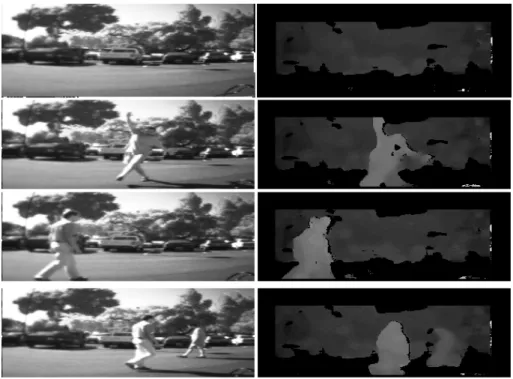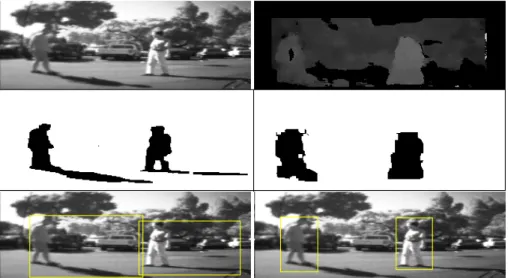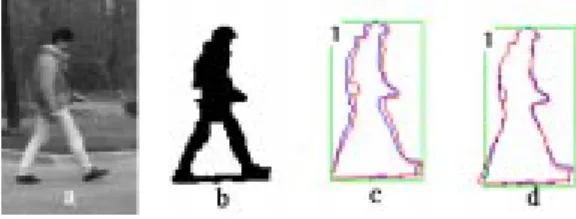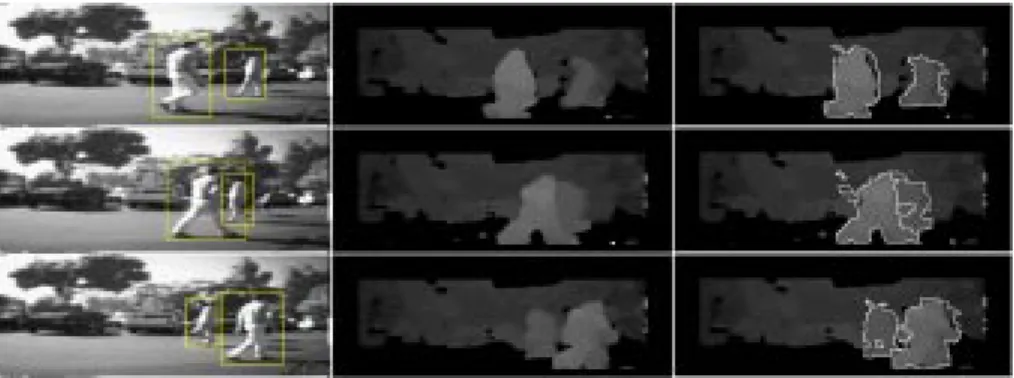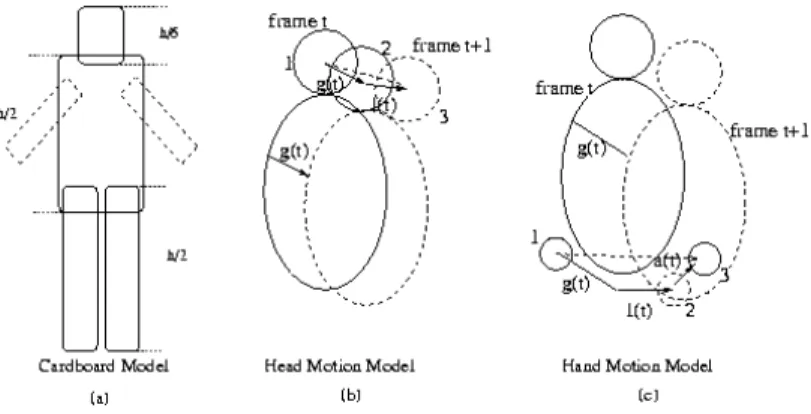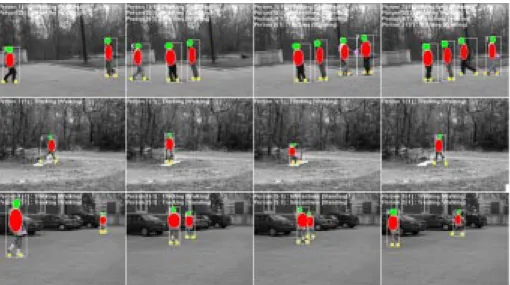W
4
S: A Real-Time System for Detecting and Tracking People in 2 1 2
DIsmail Haritaoglu, David Harwood and Larry S. Davis Computer Vision Laboratory
University of Maryland College Park, MD 20742, USA
Abstract. W 4
S is a real time visual surveillance system for detecting and tracking people and monitoring their activities in an outdoor envi- ronment by integrating realtime stereo computation into an intensity- based detection and tracking system. Unlike many systems for tracking people,W4S makes no use of color cues. Instead,W4S employs a com- bination of stereo, shape analysis and tracking to locate people and their parts (head, hands, feet, torso) and create models of people's appearance so that they can be tracked through interactions such as occlusions.W4S is capable of simultaneously tracking multiple people even with occlu- sion. It runs at 5-20 Hz for 320x120 resolution images on a dual-pentium 200 PC.
1 Introduction
W 4
Sis a real time system for tracking people and their body parts in monochro- matic stereo imagery. It constructs dynamic models of people's movements to answer questions about What they are doing, andWhere and When they act.
It constructs appearance models of the people it tracks in 221D so that it can track people (Who?) through occlusion events in the imagery.W4S represents the integration of a real-time stereo (SVM) system with a real-time person de- tection and tracking system (W4[14]) to increase its reliability. SVM [12] is a compact, inexpensive realtime device for computing dense stereo range images which was recently developed by SRI.W4 [14] is a real time visual surveillance system for detecting and tracking people in an outdoor environment using only monochromatic video.
In this paper we describe the computational models employed by W4S to detect and track people. These models are designed to allowW4S to determine types of interactions between people and objects, and to overcome the inevitable errors and ambiguities that arise in dynamic image analysis (such as instabil- ity in segmentation processes over time, splitting of objects due to coincidental alignment of objects parts with similarly colored background regions, etc.).W4S employs a combination of shape analysis and robust techniques for tracking to detect people, and to locate and track their body parts using both intensity and stereo.W4S builds \appearance" models of people so that they can be identied
after occlusions or after interactions during whichW4S cannot track them indi- vidually. The incorporation of stereo has allowed us to overcome the diculties thatW4encountered with sudden illumination changes, shadows and occlusions.
Even low resolution range maps allow us to continue to track people successfully, since stereo analysis is not signicantly eected by sudden illumination changes and shadows, which make tracking much harder in intensity images. Stereo is also very helpful in analyzing occlusions and other interactions. W4S has the capability to construct a 221D model of the scene and its human inhabitants by combining a 2D cardboard model, which represents the relative positions and size of the body parts, and range as shown in gure 1.
Fig.1. Examples of detection result: intensity image (left), detected people and their body parts form the intensity only (middle) and their placement in the 212Dscene by
W 4
S (right)
W 4
S has been designed to work with only visible monochromatic video sources. While most previous work on detection and tracking of people has relied heavily on color cues,W4Sis designed for outdoor surveillance tasks, and partic- ularly for low light level situations. In such cases, color will not be available, and people need to be detected and tracked based on weaker appearance, motion, and disparity cues. W4S is a real time system. It currently is implemented on a dual processor Pentium PC and can process between 5-20 frames per second depending on the image resolution and the number of people in its eld of view.
In the long run,W4Swill be extended with models to recognize the actions of the people it tracks. Specically, we are interested in interactions between people and objects - e.g., people exchanging objects, leaving objects in the scene, taking objects from the scene. The descriptions of people - their global motions and the motions of their parts - developed byW4Sare designed to support such activity recognition.
W 4
S currently operates on video taken from a stationary camera, and many of its image analysis algorithms would not generalize easily to images taken from a moving camera. Other ongoing research in our laboratory attempts to develop both appearance and motioncues from a movingsensor that mightalert a system to the presence of people in its eld of regard [10]. At this point, the surveillance
Fig.2.Detection and Tracking System
system might stop and invoke a system likeW4Sto verify the presence of people and recognize their actions.
The system diagram of W4S is shown in Figure 2. Area-correlation based stereo is computed by SVM. Foreground regions in both the intensity image and the range image are detected in every frame using a combination of background analysis and simple low level processing of the resulting binary images. The back- ground scene is modeled in the same way for the disparity and intensity images.
The background scene for the disparity image is statistically modeled by the min- imum and maximum disparity value and maximal temporal disparity derivative for each pixel recorded over some period. A similar statistical model is used to model the background scene for the intensity images using intensity values instead of disparity values. Both background models are updated periodically.
These algorithms are described in Section 4. The foreground regions detected in the intensity and range images are combined into a unied set of foreground regions. Each foreground region is matched to the current set of objects using a combination of shape analysis and tracking. These include simple spatial occu- pancy overlap tests between the predicted locations of objects and the locations of detected foreground regions, and \dynamic" template matching algorithms that correlate evolving appearance models of objects with foreground regions.
Second-order motion models, which combine robust techniques for region track- ing and matching of silhouette edges with recursive least square estimation, are used to predict the locations of objects in future frames. These algorithms are described in Section 6.W4Scan detect and track multiple people in complicated scenes at 5-20 Hz speed at 320x120 resolution on a 200 MHz dual pentium PC.
Pnder [1] is a real-time system for tracking a person which uses a multi-class statistical model of color and shape to segment a person from a background scene. It nds and tracks people's head and hands under a wide range of viewing condition.
[6] is a general purpose system for moving object detection and event recog- nition where moving objects are detected using change detection and tracked using rst-order prediction and nearest neighbor matching. Events are recog- nized by applying predicates to a graph formed by linking corresponding objects in successive frames.
KidRooms [3,9] is a tracking system based on \closed-world regions". These are regions of space and time in which the specic context of what is in the regions is assumed to be known. These regions are tracked in real-time domains where object motions are not smooth or rigid, and where multiple objects are interacting.
Bregler uses many levels of representation based on mixture models, EM, and recursive Kalman and Markov estimation to learn and recognize human dynamics [5]. Deformabletrackers that track smallimages of people are described in [7].
Realtime stereo systems have recently become available and applied to de- tection of people. Spnder[2] is a recent extension of Pnder in which a wide- baseline stereo camera is used to obtain 3-D models. Spnder has been used in a smaller desk-area environment to capture accurate 3D movements of head and hands. Kanade [13] has implemented a Z-keying method, where a subject is placed in correct alignment with a virtual world. SRI has been developing a person detection system which segments the range image by rst learning a background range image and then using statistical image compression methods to distinguish new objects [12], hypothesized to be people.
3 Stereo Analysis
W 4
S computes stereo using area (sum of absolute dierence) correlation after a Laplacian of Gaussian transform. The stereo algorithm considers sixteen dis- parity levels, perform postltering with an interest operator, and a left-right consistency check, and nally does 4xrange interpolation. The stereo computa- tion is done either in the SVM or on the host PC, the latter option providing us access to much better cameras than those used in the SVM. SVM is a hardware and software implementation of area correlation stereo which was implemented and developed by Kurt Konolige at SRI. The hardware consists of two CMOS 320x240 grayscale imagers and lenses, low-power A/D converter, a digital signal processor and a smallash memoryfor program storage. A detailed description of the SVM can be found in [12]. SVM performs stereo at two resolutions (160x120 or 320X120) in the current implementation, with speed of up to 8 frames per second. The SVM uses CMOS imagers; these are an order of magnitude nois- ier and less sensitive than corresponding CCD's. Higher quality cameras can be
Fig.3. Examples of the range images calculated by area correlation stereo utilized by W4S, with the stereo algorithm running on the host PC, to obtain better quality disparity images.
Figure 3 shows a typical disparity image produced by the SVM. Higher dis- parities (closer objects) are brighter. There are 64 possible levels of disparity and disparity 0 (black areas) are regions where the range data is rejected by the post-processor interest operator due to insucient texture.
4 Background Scene Modeling and Foreground Region
Detection
The background scene is modeled and the foreground regions are detected in both the intensity image and the disparity image simultaneously. Frame dier- encing inW4S is based on a model of background variation obtained while the scene contains no people. The background scenes for the intensity images (the disparity images) are modeled by representing each pixel by three values; its minimumand maximumintensity (disparity) values and the maximum intensity (disparity) dierence between consecutive frames observed during this training period. These values are estimated over several seconds of video and are up-
dated periodically for those parts of the scene that W4S determines to contain no foreground objects.
Foreground objects are segmented from the background in each frame of the video sequence by a four stage process: thresholding, noise cleaning, morpholog- ical ltering and object detection. This foreground object detection algorithm is simultaneously applied to both the intensity and disparity image. The objects detected in the intensity image and the disparity image are integrated to con- struct the set of objects that are included in the list of foreground objects, and subsequently tracked. The following detection method is explained only for the intensity images; it is the same for the disparity images.
Each pixel is rst classied as either a background or a foreground pixel using the background model. Giving the minimum(M), maximum(N) and the largest interframe absolute dierence (D) images that represent the background scene model, pixelxfrom imageI is a foreground pixel if:
jM(x),I(x)j>D(x) or jN(x),I(x)j>D(x) (1) Thresholding alone, however, is not sucient to obtain clear foreground re- gions; it results in a signicant level of noise, for example, due to illumination changes.W4S uses region-based noise cleaning to eliminate noise regions. After thresholding, one iteration of erosion is applied to foreground pixels to eliminate one-pixel thick noise. Then, a fast binary connected-component operator is ap- plied to nd the foreground regions, and small regions are eliminated. Since the remaining regions are smaller than the original ones, they should be restored to their original sizes by processes such as erosion and dilation. Generally, nding a satisfactory combination of erosion and dilation steps is quite dicult, and no xed combination works well, in general, on our outdoor images. Instead,W4S applies morphological operators to foreground pixels only after noise pixels are eliminated. So,W4Sreapplies background subtraction, followed by one iteration each of dilation and erosion, but only to those pixels inside the bounding boxes of the foreground regions that survived the size thresholding operation.
5 Foreground Region Selection
The foreground object detection algorithm is applied to both the disparity im- ages and the intensity images for each frame in the video sequence. Generally, intensity-based detection works better than stereo-based detection when the il- lumination does not change suddenly or when there are no strong light sources that causes sharp shadows. The main advantage of the intensity-based analysis are that
{ Range data may not available in background areas which do not have suf- cient texture to measure disparity with high condence. Changes in those areas will not be detected in the disparity image. However, the intensity- based algorithm can detect low textured areas when the brightness of the foreground regions diers signicantly from the background.
Fig.4.An example showing that how stereo-based detection eliminates shadows during object detection.
{ Foreground regions detected by the intensity-based method have more ac- curate shape (silhouette) then the range-based method. The silhouette is very useful for tracking via motion estimation, and in constructing the appearance-based body model used to locate and track body parts.
However, there are three important situations where the stereo-based detection algorithm has an advantage over the intensity algorithm
{ When there is a sudden change in the illumination, it is more likely that the intensity-based detection algorithm will detect background objects as fore- ground objects. However, the stereo-based detection algorithm is not eected by illuminationchanges over short periods of time as much as intensity-based detection.
{ Shadows, which makes intensity detection and tracking harder, do not cause a problem in the disparity images as disparity does not change from the background model when a shadow is cast on the background. Figure 4 shows the foreground regions and their bounding boxes detected by the intensity based (left) and stereo-based detection (right) methods.
{ The stereo-based method more often detects intact foreground objects than the intensity-based method. Intensity-based foreground detection often splits foreground objects into multiple regions due to coincidental alignment of the objects parts with similarly colored background regions.
After foreground objects are detected in both the intensity image and the disparity image,W4S merges these objects into one set of objects. Objects are selected for tracking as follows:
A graph is constructed in which disparity region is linked to an intensity region that it signicantly overlaps (60%). The connected components of this graph are then considered as possible foreground objects. Generally, we nd large disparity regions with poorly dened shapes that overlap a few intensity regions arising from fragmentation of a foreground object. When a connected component contains only one intensity and one disparity region that have very high overlap, then we represent the foreground object by their intersection.
A connected component is rejected if it contains a region only from the inten- sity image and disparity is available for that region (but does not dier from the background, since no disparity foreground region was detected). This is prob- ably due to an illumination change or shadow. As the nal step of foreground region detection, a binary connected component analysis is applied to the se- lected foreground regions to assign a unique label to each foreground object.
W 4
S generates a set of features for each detected foreground object, including its local label, centroid, median, median of the disparity, and bounding box.
Fig.5. Motion estimation of body using Silhouette Edge Matching between two suc- cessive frame a: input image; b: detected foreground regions; c: alignment of silhouette edges based on dierence in median; d: nal alignment after silhouette correlation
6 Object Tracking
The goals of the object tracking stage are to:
{ determine when a new object enters the system's eld of view, and initialize motion models for tracking that object.
{ compute the correspondence between the foreground regions detected by the background subtraction and the objects currently being tracked byW4S. { employ tracking algorithms to estimate the position (of the torso) of each
object, and update the motion model used for tracking.W4Semploys second order motion models (including a velocity and, possibly zero, acceleration terms) to model both the overall motion of a person and the motions of its parts.
W 4
S has to continue to track objects even in the event that its low level detection algorithms fail to segment people as single foreground objects. This
might occur because an object becomes temporarily occluded (by some xed object in the scene), or an object splits into pieces (possibly due to a person depositing an object in the scene, or a person being partially occluded by a small object). Finally, separately tracked objects might merge into one because of interactions between people. Under these conditions, the global shape analysis and tracking algorithms generally employed by W4S will fail, and the system, instead, relies on stereo to locate the objects and local correlation techniques to attempt to track parts of the interacting objects. Stereo is very helpful in analyzing occlusion and intersection. For example, in Figure 6 one can determine which person is closest to the camera when two or more people interact and one is occluded by the other. We can continue to track the people by segmenting the range data into spatially disjoint blobs until the interaction is complete. The range data gives helpful cues to determine \who is who" during and after the occlusion.
W 4
S rst matches objects to current foreground regions by nding overlap between the estimated (via the global motion model) bounding boxes of objects and the bounding boxes of foreground regions from the current frame. For each object, all current foreground regions whose bounding boxes overlap suciently are candidates for matching that object. Ideally, one to one matching (tracking) would be found while tracking one object. However, one to many (one tracked object splits into several foreground regions ), many to one (two or more tracked objects merge into one foreground region), one to zero (disappearing) and zero to one (appearing) matchings occur frequently.W4S tracks objects using dierent methods under each condition.
6.1 Appearing Objects
When a foreground region is detected whose bounding box does not suciently overlap any of the existing objects, it is not immediately evident whether it is a true object or a noise region. If the region can be tracked successfully through several frames, then it is added to the list of objects to be monitored and tracked.
6.2 Tracking
Here, we consider the situation that an object continues to be tracked as a single foreground region. W4S employs a second order motion model for each object to estimate its location in subsequent frames. The prediction from this model is used to estimate a bounding box location for each object. These predicted bounding boxes are then compared to the actual bounding boxes of the detected foreground regions. Given that an object is matched to a single foreground region (and the sizes of those regions are roughly the same)W4Shas to determine the current position of the object to update its motion model. Even though the total motion of an object is relatively small between frames, the large changes in shape of the silhouette of a person in motion causes simple techniques, such as tracking the centroids of the foreground regions, to fail. Instead,W4Suses a two stage matching strategy to update its global position estimate of an object. The
Fig.6. An Example how range data is useful to track the people by segmenting the range data during occlusion
initial estimate of object displacement is computed as the motion of the
median
coordinate of the object. This median coordinate is a more robust estimate of object position, and is not eected by the large motions of the extremities (which tend to inuence the centroid signicantly). It allows us to quickly narrow the search space for the motion of the object. However, this estimate is not accurate enough for long term tracking. Therefore, after displacing the silhouette of the object from the previous frame by the median-based estimate, we perform a binary edge correlation between the current and previous silhouette edge proles.
This correlation is computed only over a 5x3 set of displacements. Typically, the correlation is dominated by the torso and head edges, whose shape changes slowly from frame to frame. This tracking process is illustrated in gure 5.
6.3 Region splitting
An object being tracked might split into several foreground regions, either due to partial occlusion or because a person deposits an object into the scene. In this case, one object will be matched to two or more current foreground regions.
W 4
S determines whether the split is a true-split or a false-split (due to noise transient) condition by monitoring subsequent frames, while tracking the split objects as individual objects. If W4S can track the constituent objects over several frames, then it assumes that they are separate objects and begins to track them individually.
6.4 Region merging
When two people meet they are segmented as one foreground region by the background subtraction algorithm.W4S recognizes that this occurs based on a simple analysis of the predicted bounding boxes of the tracked objects and the bounding box of the detected (merged) foreground region. The merged region
Fig.7.W 4
Suses range data to detect the people during occlusion and determine their relative location in 212D
is tracked until it splits back into its constituent objects. Since the silhouette of the merged regions tends to change shape quickly and unpredictably, W4S uses a simple extrapolation method to construct its predictive motion model for the merged objects, and simple disparity segmentation method to predict the location of the objects during interactions. A segmentation is applied to the disparity data only inside the merged regions to locate the interacting objects.
A hierarchical connected component algorithm [15] is used for segmentation.
The disparity segmentation can successfully distinguish the objects when they are at dierent ranges as shown in gure 6. Intensity alone cannot determine whether or not the the people are in close proximity when their images merge into one foreground regions. Stereo helps W4S to recover the relative distance among people when they are in the same foreground region. Figure 7 shows two examples of W4S tracking people by illustrating their locations in 212D.
A problem that arises when the merged region splits, and the people \re- appear", is determining the correspondence between the people that were tracked before the interaction and the people that emerge from the interaction. To ac- complish this,W4Suses two types of appearance models that it constructs while it is tracking an isolated person.
W 4
S constructs a dynamic template -called a temporal texture template - while it is tracking an isolated object. The temporal texture template for an
Fig.8.An example of how temporal templates are updated over time object is dened by:
t(x;y) =I(x;y) +wt,1(x;y) t,1(x;y)
w
t,1(x;y) + 1 (2)
Here, I refers to the foreground region detected during tracking of the object, and all coordinates are represented relative to the
median
of the template or foreground region. The weights in (2) are the frequency that a pixel in is detected as a foreground pixel during tracking. The initial weightswt(x;y) of are zero and are incremented each time that the corresponding location (relative to the median template coordinate)is detected as a foreground pixel in the input image. An example of how the temporal texture template of a person evolves over time is shown in gure 8.Fig.9. An example forW4S tracking; two people are entering, walking, meeting and leaving
After separation, each constituent object is matched with the separating ob- jects by correlating their temporal templates. Since the temporal texture tem-
plate is view-based, it could fail to match if there were a large change in the pose of the object during the occlusion event. Therefore, a non-view-based method, which uses a symbolic object representation, is also used to analyze the occlu- sion. For example, if the temporal texture templates fail to yield suciently high correlation values, then we match objects based on the average intensities in their upper, lower and middle parts, in an attempt to identify objects when they separates. Figure 9 illustratesW4S tracking objects; W4S detects people, assigns unique labels to them and tracks them through occlusion and interaction.
Fig.10.Cardboard model used inW4S (a), and motion models used for the head (b) and hands (c).
7 Tracking People's Parts
In addition to tracking the body as a whole, we want to locate body parts such as the head, hands, torso, legs and feet, and track them in order to understand actions. W4S uses a combination of shape analysis and template matching to track these parts (when a person is occluded, and its shape is not easily pre- dictable, then only template matching is used to track body parts). The shape model is implemented using a a Cardboard Model[11] which represents the rel- ative positions and sizes of the body parts. Along with second order predictive motion models of the body and its parts, the Cardboard Model can be used to predict the positions of the individual body parts from frame to frame. Figure 10 illustrates the motion models used for the hands and head. These positions are veried (and rened) using dynamic template matching based on the temporal texture templates of the observed body parts.
The cardboard model represents a person who is in an upright standing pose, as shown in gure 10(a). It is used to predict the locations of the body parts (head, torso, feet, hands, legs). The height of the bounding box of an object
Fig.11. An example of Cardboard Model to show How Head, Torso, Legs Hands and Feet are Located. Initial Bounding boxes are located on foreground regions (a);
Cardboard model analysis locates the body part (b); illustration of body part location by ellipsis (c)
is taken as the height of the cardboard model. Then, xed vertical scales are used to determine the initial approximate location (bounding box) of individual body parts, as shown in Figure 11. The lengths of the initial bounding boxes of the head, torso, and legs are calculated as 1/5, 1/2 and 1/2 of the length of bounding box of the object, respectively. The widths of the bounding boxes of the head, torso, and legs are calculated by nding the median width (horizontal line widths) inside their initial bounding boxes. In addition to nding sizes and locations, the moments of the foreground pixels inside the initial bounding boxes are calculated for estimating their principal axis. The principal axis provide information about the pose of the parts. The head is located rst, followed by the torso and legs. The hands are located after the torso by nding extreme regions which are connected to the torso and are outside of the torso. The feet are located as extreme regions in the direction of the principal axes of the respective leg. Figure 11 show an example of how the cardboard model can be used to predict the locations of body parts in two stages (approximate initial location and nal estimated location) and represent them as ellipsis.
After predicting the locations of the head and hands using the cardboard model, their positions are veried and rened using temporal texture templates.
These temporal texture templates are then updated as described previously, unless they are located within the silhouette of the torso. In this case, the pixels corresponding to the head and hand are embedded in the larger component corresponding to the torso. This makes it dicult to accurately estimate the median position of the part, or to determine which pixels within the torso are actual part pixels. In these cases, the parts are tracked using correlation, but the templates are not updated.
The correlation results are monitored during tracking to determine if the correlation is good enough to track the parts correctly. Analyzing the changes in the correlation scores allows us to make predictions about whether a part is be- coming occluded. For example, the graph in Figure 13 shows how the correlation (sum of absolute dierences, SAD) results for the left hand of a person changes over time. Time intervals I,II,III and IV in the graph are the frame intervals in
Fig.12. Examples of using the cardboard model to locate the body parts in dierent actions: four people meet and talk (rst line), a person sits on a bench (second line), two people meet (third line).
which the left hand is occluded by the body, and they have signicantly worse correlation scores (higher SAD).
8 Discussion
We described a real time visual surveillance system (W4S) for detecting and tracking people and monitoring their activities in an outdoor environment by integrating realtime stereo computation into an intensity-based detection and tracking system.W4S has been implemented in C++ and runs under the Win- dows NT operating system. Currently, for 320x120 resolution images,W4S runs at 20 Hz on a PC which has dual 200 Mhz pentium processor. It has the capa-
Fig.13. An Example of hands and head tracking of a walking person and correlation results for the left hand of that person.
bility to track multiple people against complex background. Figure 12 illustrates some results of the W4S system in scenes of parking lots and parkland.
There are several directions that we are pursuing to improve the performance ofW4Sand to extend its capabilities. Firstly, the cardboard model used to pre- dict body pose and position is restricted to upright people. We would like to be able to recognize and track people in other generic poses, such as crawling, climbing, etc. We believe this might be accomplished based on an analysis of convex hull-like representations of the silhouettes of people. Finally, our long term goal is to be able to recognize interactions between the people that W4S is tracking. We are studying the use of temporal logic programs for the repre- sentation of actions, and to control the application of visual routines to peoples movements.
References
1. C. Wren, A. Azarbayejani, T. Darrell, A. Pentland \Pnder: Real-Time Tracking ofthe Human Body", In Proc. of the SPIE Conference on Integration Issues in Large Commercial Media Delivery Systems, October 1995.
2. A. Azarbayejani, C. Wren and A. Pentland \Real-Time Tracking of The HumanBody"In Proc. IMAGE COM 96, Bordeaux, France, May 1996 3. S. Intille, J. Davis, A. Bobick \Real-Time Closed-Word Tracking", In Proc. of
CVPR, pp.697-703, June 1997
4. A. F. Bobick and J. Davis \Real-Time recognition of activity using TemporalTem- plates"In Proc. Third IEEE Workshop on Application of Computer Vision,pp.1233- 1251, December, 1996
5. C. Bregler \Learning and Recognizing Human Dynamics in Video Sequences" In Proc. CVPR 97, pp.569-574, June 1997
6. T. Olson, F. Brill \Moving Object Detection and Event Recognition algorithms forSmart Cameras"1997. In Proc. DARPA Image Understanding Workshop, pp.159-176, May 7. R. Polona, R. Nelson \Low Level Recognition of Human Motion", In Proc. Non
Rigid Motion Workshop, November 1994.
8. A. Pentland \Machine Understanding Human Actions"Understanding Workshop,pp.757-764, 1996. In Proc. DARPA Image 9. A. Bobick, J. Davis, S. Intille, F. Baird, L. Cambell, Y. Irinov, C. Pinhanez, A.Wilson \KidsRoom: Action Recognition In An Interactive Story environment"M.I.T.
TR No: 398, December 1996
10. S. Fejes, L.S. Davis \Exploring Visual Motion Using Projections of Flow Fields"
In. Proc. of the DARPA Image Understanding Workshop, pp.113-122 New Orleans, LA,1997
11. S. Ju, M. Black, Y. Yacoob, \Cardboard People: A Parameterized Model of Ar-ticulated Image Motion",1996 International Conference on Face and Gesture Analysis, 12. K. Konolige \Small Vision systems: Hardware and Implementation",Eighth Inter-
national Symposium on Robotics Research, Hayama, Japan, November, 1997 13. T. Kanade, \A Stereo Machine For Video Rate Dense Depth Mapping and Its NewApplication", In Proc. CVPR, 1996.
14. |{, \W4: Who, When, Where, What: A Real Time System for Detecting andTracking People" Submitted to Face and Gesture Recognition Workshop, 1998. 15. T. Westman, D. Harwood, T. Laitinen, M. Pietikainen \Color Segmentation by Hi-erarchical Connected Components Analysis With Image Enhancement by Symmetric
Neighborhood Filters" In Proc. CVPR, pp:796-802, June, 1990

